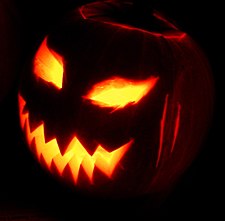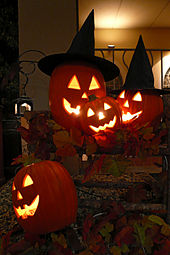
Typical festive Halloween activities include trick-or-treating (also known as "guising"), attending costume parties, carving jack-o'-lanterns, lighting bonfires, apple bobbing, visiting haunted attractions, playing pranks, telling scary stories, and watching horror films, as well as the religious observances of praying, fasting and attending vigils or church services.
History of HALLOWEEN
The word Halloween was first used in the 16th century and represents a Scottish variant of the fuller All-Hallows'-Even ("evening"), that is, the night before All Hallows' Day.[10] Although the phrase All Hallows' is found in Old English (ealra hālgena mæssedæg, mass-day of all saints), All-Hallows-Even is itself not seen until 1556.
Christian Influences:
Halloween is also thought to have been heavily influenced by the Christian holy days of All Saints' Day (also known as Hallowmas, All Hallows, and Hallowtide) and All Souls' Day. Falling on November 1 and 2 respectively, collectively they were a time for honoring the saints and praying for the recently departed who had yet to reach heaven. By the end of the 12th century they had become holy days of obligation across Europe and involved such traditions as ringing bells for the souls in purgatory and "souling", the custom of baking bread or soul cakes for "all crysten christened souls". It was traditionally believed that the souls of the departed wandered the earth until All Saints' Day, and All Hallows' Eve provided one last chance for the dead to gain vengeance on their enemies before moving onto the next world. To avoid being recognised by a soul, Christians would wear masks and costumes to disguise themselves, following the lighted candles set by others to guide their travel for worship the next day.[18] Today, this practice has been perpetuated through children guising (trick or treating).
In Britain the rituals of Hallowtide and Halloween came under attack during the Reformation as Protestants denounced purgatory as a "popish" doctrine incompatible with the notion of predestination.[16] In addition the increasing popularity of Guy Fawkes Night (5 November) from 1605 on saw Halloween become eclipsed in Britain with the notable exception of Scotland. There and in Ireland, they had been celebrating Samhain and Halloween since the early Middle Ages, and the kirk took a more pragmatic approach towards Halloween, viewing it as important to the life cycle and rites of passage of local communities and thus ensuring its survival in the country. North American almanacs of the late 18th and early 19th century give no indication that Halloween was recognized as a holiday. The Puritans of New England, for example, maintained strong opposition to the holiday and it was not until the mass Irish and Scottish immigration during the 19th century that the holiday was introduced to the continent in earnest. Initially confined to the immigrant communities during the mid-19th century, it was gradually assimilated into mainstream society and by the first decade of the 20th century it was being celebrated coast to coast by people of all social, racial and religious backgrounds.
Symbols
Development of artifacts and symbols associated with Halloween formed over time. For instance, the carving of jack-o'-lanterns springs from the Christian souling custom of carving turnips into lanterns as a way of remembering the souls held in purgatory. The turnip has traditionally been used in Ireland and Scotland at Halloween, but immigrants to North America used the native pumpkin, which is both much softer and much larger – making it easier to carve than a turnip. Subsequently, the mass marketing of various size pumpkins in autumn, in both the corporate and local markets, has made pumpkins universally available for this purpose. The American tradition of carving pumpkins is recorded in 1837 and was originally associated with harvest time in general, not becoming specifically associated with Halloween until the mid-to-late 19th century.

The imagery of Halloween is derived from many sources, including national customs, works of Gothic and horror literature (such as the novels Frankenstein and Dracula) and classic horror films (such as Frankenstein and The Mummy). One of the earliest works on the subject of Halloween is from Scottish poet John Mayne, who, in 1780, made note of pranks at Halloween; "What fearfu' pranks ensue!", as well as the supernatural associated with the night, "Bogies" (ghosts), influencing Robert Burns' Halloween 1785. Elements of the autumn season, such as pumpkins, corn husks and scarecrows, are also prevalent. Homes are often decorated with these types of symbols around Halloween.
Halloween imagery includes themes of death, evil, the occult, and mythical monsters. Black and orange are the holiday's traditional colors.
No comments:
Post a Comment